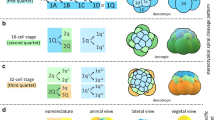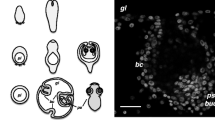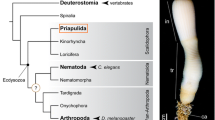Abstract
In this paper we describe the embryonic development of the polyclad flatworm Imogine mcgrathi. Imogine is an indirect developer that hatches as a planctonic Goette’s larva after an embryonic period of approximately 7 days. Light and electron microscopic analyses of sections of staged embryos were combined with antibody stainings of wholemounted embryos to reconstruct the origin and movement of the primordia of the various organ systems, with particular emphasis on the nervous system. We introduce a system of morphologically defined stages aimed at facilitating future studies and cross-species comparisons among flatworm embryos. Imogine embryos undergo typical spiral cleavage. Micromere quartets 1–3 form an irregular double layer of mesenchymal cells that during gastrulation expands over micromere quartet 4. Micromere 4d divides into several large mesendodermal precursors whose position defines the ventral pole of the embryo. These cells, along with the animal micromeres that obtained a sub-surface position during cleavage, form a deep layer of cells that gives rise to all internal structures, including the nervous system, musculature, nephridia, and gut. Micromeres 4a–c are large yolky cells that are incorporated into the lumen of the gut, but do not themselves contribute to the gut epithelium. Shortly after gastrulation, cell differentiation sets in. Cells located at the surface adopt epithelial characteristics and form cilia that result in continuous movement of the post-gastrula stage embryo. Deep cells at the lateral margins of the embryo become organized into a protonephridial tube. A cluster of approximately 50 deep cells at the anterior pole forms the brain, in which we have identified sets of founder neurons of the brain commissure and the dorsal and ventral connectives. The early differentiating neurons, along with other cells forming stabilized microtubules (ciliated cells of the epidermis, gut and protonephridia; apical gland cells) could be analyzed in detail because of their labeling with an antibody against acetylated α-tubulin. Our findings indicate that, despite significant differences in the cleavage pattern and arrangement of blastomeres in the early embryo, morphogenesis and organ formation of a polyclad embryo follows a pattern that is very similar to the pattern observed by us and others in phylogenetically more evolved rhabdocoel flatworms.
Similar content being viewed by others
Author information
Authors and Affiliations
Additional information
Received: 10 February 2000 / Accepted: 10 April 2000
Rights and permissions
About this article
Cite this article
Younossi-Hartenstein, A., Hartenstein, V. The embryonic development of the polyclad flatworm Imogine mcgrathi . Dev Gene Evol 210, 383–398 (2000). https://doi.org/10.1007/s004270000086
Issue Date:
DOI: https://doi.org/10.1007/s004270000086




